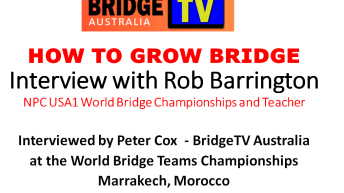This article was taken from Andrew’s What Should Have Happened Book
If one opponent plays a critical card in a suit, his partner is twice as likely to have the adjacent card in the same suit. This is because of the Principle of Restricted Choice (“PRC”) – a mathematical theory that was found to have relevance at the bridge table by Terence Reese. He first expounded the theory in his epic book “The Expert Game”, written in 1958 – an inspirational read for any ambitious player.
| South Deals N-S Vul |
♠ A 10 5 3 2 ♥ A Q 3 ♦ A Q 3 ♣ K Q |
||||||||||
|
♠ Q 9 8
♥ 10 9 8 6 ♦ 8 4 2 ♣ 9 7 5 |
|
♠ J
♥ 5 4 2 ♦ 10 9 6 5 ♣ 10 8 4 3 2 |
|||||||||
| ♠ K 7 6 4 ♥ K J 7 ♦ K J 7 ♣ A J 6 |
|||||||||||
| West | North | East | South |
| 1 ♠ | |||
| Pass | 4 N | Pass | 5 ♦ |
| Pass | 5 N | Pass | 6 ♠ |
| Pass | 7 ♠ | Pass | Pass |
| Pass |
| 7 ♠ by South |
North used the Blackwood convention (4NT) to ask for aces, and when his partner’s 5♦ response (one ace) revealed that all aces were present, he bid 5NT to ask for kings. South’s 6♠ response indicated possession of the three missing kings so North bid the Grand Slam.
West’s ♥10 lead ran to declarer’s ♥J and declarer cashed ♠K. East’s ♠J fell and declarer used PRC to deduce that West was now twice as likely to hold the adjacent card – ♠Q. Thus when he followed by leading ♠4 and West played ♠9, he crossed his fingers and inserted ♠10. East discarded a ♣ so he breathed a sigh of relief, cashed ♠A felling West’s ♠Q, and claimed his Grand Slam.
ANDREW’S TIP: When one opponent plays a critical card in a suit, play his partner to have the adjacent card in the same suit.




Add comment